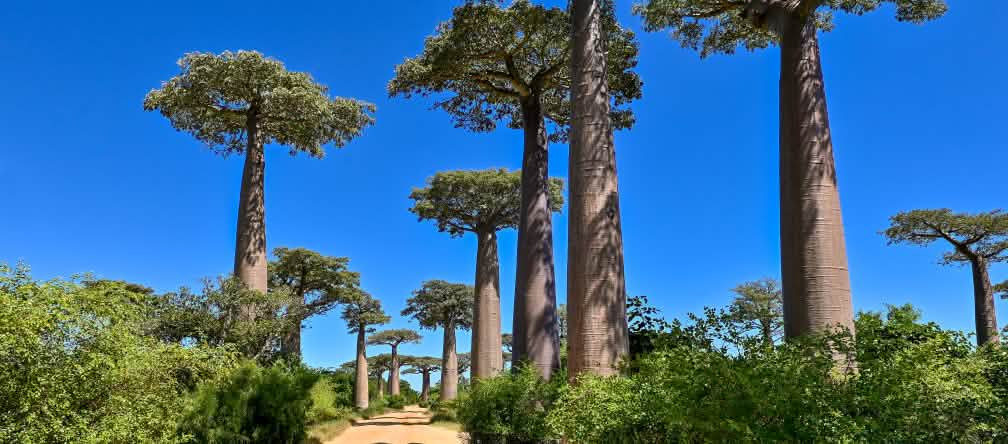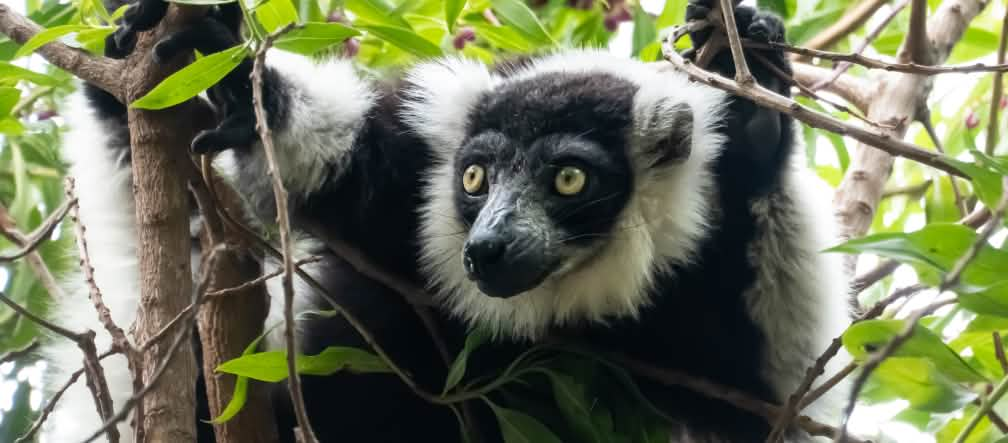Defend Madagascar’s biodiversity – stop the mining rush NOW!
Madagascar has raw materials sought by the European Union – including rare earths, graphite, and other elements. The EU considers these critical for the energy transition, digital innovation, and defense. However, mining leads to human rights violations and widespread environmental destruction. This must stop.
To: Andry Rajoelina, President of the Republic of Madagascar; Ursula von der Leyen, President of the European Commission
“Respect human rights and protect the environment when mining rare earths.”Madagascar is one of the most biodiverse countries in the world.
Its ecosystems include several types of forests, savannas, steppes, wetlands, and mangroves. Many species are endemic: 96 percent of its 12,000 vascular plant species, all 278 amphibian species, and all 104 lemur species and subspecies exist nowhere else on Earth. Among them is the critically endangered Silky Sifaka (Propithecus candidus), known as the “angel of the forest.”
Recently, the European Union and international corporations have shown increasing interest in Madagascar as a source of rare earths, graphite, and other materials they consider “critical” for the energy transition, digital innovation, and defense.
For example, the Base Toliara rare earths project covers a 1,000 km² mining area, including the construction of processing facilities, roads, and a port. Local communities have marched and protested against the project since its inception. As a result, the project was paused in 2019. Scientists have warned of radioactive contamination caused by the mining operations.
When the government announced plans to resume the project, 20,000 people participated in a demonstration. Despite public resistance, the suspension was lifted on November 28, 2024. Authorities have used violence against community members and arrested land defenders.
While the transition away from fossil fuels is essential to addressing the climate crisis, it must not harm local communities, destroy ecosystems, or intensify the crisis itself. Unfortunately, that is exactly what is happening in Madagascar.
In solidarity with affected communities, we call on the government of Madagascar to stop the Base Toliara project, reject similar proposals, and end the violence, harassment, and criminalization of those who speak out.
The European Union must end mining policies that harm local communities, ecosystems, and the climate — in Madagascar and beyond.
Involved companies
In October 2024, the US-based uranium and critical minerals producer Energy Fuels Resources Inc. acquired the Australian company Base Resources and, with it, full ownership of the #Toliara Project#. The extracted monazite concentrate is set to be processed at White Mesa, a mill in the United States operated by Energy Fuels.
On December 5, 2024, Energy Fuels and the government of Madagascar signed a Memorandum of Understanding outlining the next steps for the project. The agreement states that the company will “pay a royalty of five percent (5%) on mined products (and no additional fees) and provide US$80 million for development, community, and social projects following certification of the project.” In an earlier statement, CEO Mark S. Chalmers had said that Toliara could become the “crown jewel” of Madagascar’s economy. Whether these points are truly compatible is open to interpretation.
Mining in Madagascar
The Base Toliara project involves the extraction of heavy mineral sands (HMS: ilmenite, rutile, and zircon) and monazite concentrate. The project is likely to pose serious risks to human rights, as it threatens local communities’ access to water, land, and forest resources. Any form of environmental pollution further endangers their way of life.
Radiation hazards
Radioactivity-related risks from ilmenite, zircon, and rutile mining in the Ranobe region are particularly concerning. A 2014 scientific study reported that uranium and thorium emissions in the area are so elevated that “serious radiation protection measures” must be implemented to protect both workers in direct contact with the ores and the local population from the risk of “cancer or congenital disorders.” This radiation exposure also poses a threat to endemic wildlife and natural ecosystems.
A pre-feasibility study published by Base Resources, then the project owner, confirmed that the sands in Ranobe contain uranium and thorium. Due to this radioactivity, the extracted materials cannot be exported to the United States or Japan.
A follow-up pre-feasibility study by Base Resources, released in December 2023, further emphasized these radiation risks for both workers and local residents, stressing that they must be “properly managed.”
What are rare earths?
The term “rare earths” refers to a group of 17 metals that commonly occur together in nature. Despite the name, they are neither soils nor inherently rare—but they are difficult and costly to extract. Mining them often causes significant environmental damage. Processing can also produce radioactive isotopes and toxic wastewater.
According to Statista, global reserves of rare earths exceed 110 million metric tons, including 44 million in China, 22 million in Brazil, 21 million each in Vietnam and Russia, and 7 million in India. Most of the world’s rare earths are processed in China.
Rare earths have many industrial uses. Europium is used in television displays, cerium for polishing glass, and lanthanum in catalytic converters for gasoline engines. Neodymium and dysprosium are essential for magnets in offshore wind turbines. These metals are also found in drones, hard drives, telescope lenses, missiles, and military aircraft.
Madagascar’s rural population
Eighty percent of Madagascar’s population lives in rural areas and depends on subsistence farming along with the export of vanilla, coffee, and cocoa. Any harm to soil quality or agriculture directly affects food security—especially for women. These challenges are made worse by the climate crisis, which is causing increasingly severe droughts, cyclones, and floods. Mining projects further compromise the land and deplete already limited water resources.
To: Andry Rajoelina, President of the Republic of Madagascar; Ursula von der Leyen, President of the European Commission
We write to express our urgent concerns regarding the expansion of mining projects in Madagascar, intended to support the so-called energy transition in the Global North. This transition demands critical minerals — including graphite and rare earths — that are found in Madagascar.
Existing and proposed mining operations threaten the livelihoods and fundamental human rights of affected communities and future generations. They damage the environment and exacerbate the impacts of the climate crisis throughout the country.
We wish to highlight the Base Toliara rare earths project, which spans a mining area of 1,000 km² and involves the construction of processing facilities, access roads, and a port on the beach at Andaboy. The local population has protested and marched against this project since its inception. In response, the project was initially suspended. Scientists have raised concerns about radioactivity released by the mining activities. After the government announced its intention to allow the project to proceed, 20,000 people took part in a demonstration. Despite this public opposition, the suspension was lifted on November 27, 2024. Alarmingly, government authorities have used violence against community members and arrested land defenders, as occurred on April 6 and April 27, 2025.
The loss of land and livelihoods for tens of thousands of farmers and fishers in the region as a result of mining activities cannot be offset by the jobs that mining companies claim to create.
We respectfully urge the Government of Madagascar to:
- Permanently cancel the Base Toliara project
- Refuse approval of proposed and future mining operations that harm local communities, destroy the environment, and worsen the climate crisis
- End the use of violence, harassment, and prosecution against critics, including land defenders, environmentalists, and community members
We call on the European Commission to:
- End policies that harm local communities in Madagascar and other countries in the Global South — policies that destroy the environment and exacerbate the climate crisis in the name of climate protection and the so-called energy transition.
Yours faithfully,
How the climate and rainforests are linked
Rainforests are complex ecosystems in which a vast number of animal, plant and fungi species are tightly interdependent. They play a major role in the local and global climate: In a process called photosynthesis, plants absorb the greenhouse gas carbon dioxide (CO2) from the air. With the help of water and sunlight, they form sugar and from it other plant building blocks. In doing so, plants sequester carbon in stems, leaves and roots while releasing oxygen into the atmosphere.
According to studies, rainforests sequester 250 billion tons of CO2, much of it in peat forests. Globally, this is equal to 90 times the man-made greenhouse gas emissions per year.
Rainforests themselves produce a large part of the high year-round rainfall they receive. Evapotranspiration, i.e. the moisture that the plants release through their leaves, is an important aspect here. The forests are hot and humid, but the clouds reflect much of the sunlight back into space – thus cooling the atmosphere. Without this effect, the areas would be even warmer.
As carbon sinks and rainmakers, intact forests play an important role in regulating the climate and are crucial to the fight against catastrophic climate change.
The problem: catastrophic climate change and forest destruction
Rainforests are increasingly unable to act as climate stabilizers: When they are destroyed for plantations, grazing area or mining projects, vast amounts of greenhouse gases are released. For example, forest fires in Indonesia accounted for one-third of total global emissions in 1997. The loss of peat forests is particularly devastating.
According to a study published by Nature, rainforests could tip from carbon sinks to carbon emitters solely due to changing climatic and growth conditions from 2035 onward – thus accelerating catastrophic climate change.
Because of the intricate interdependencies of the rainforest ecosystem, the entire web can suffer if it is damaged in one place. Take the water cycle, for example. If drier periods occur as a result of global climate change – and this is already being observed – the cycle may break down. This can lead to evergreen, lush rainforests becoming grasslands with far lower biodiversity. The local climate would become drier and hotter.
The 18 tipping points in the climate system are particularly ominous: If, for example, climate change in the Amazon region reaches a certain point, the process and the loss of the rainforest in its current form will become unstoppable.
One thing is clear: catastrophic climate change is man-made. 98 percent of the scientists who study climate issues agree. Because the climate is a highly complex system, researchers are constantly discovering new relationships, interpreting data in different ways and revising forecasts. This is completely normal in science. However, the findings of climatologists are becoming increasingly alarming.
The solution: rainforest protection is climate protection
Rainforests must be preserved because they are indispensable as carbon sinks and their further destruction would worsen the impact of catastrophic climate change. Climate protection is therefore rainforest protection and vice versa.
- We need to preserve forests and nature and heal damage. Forests are more than just carbon sinks – they are diverse ecosystems and home to millions of people.
- We need to protect the climate while preserving biodiversity. Catastrophic climate change and extinction are two existential crises that we must tackle together.
- We need to secure and strengthen the rights of indigenous peoples, who are often the forest's best stewards: We call it the rainforest – they call it home.
- We need to fundamentally change our way of life and how we do business: This will mean reducing our consumption of energy, food and raw materials instead of maintaining it by turning to “green products”. We must stop burning fossil fuels.
- We need to reform flawed climate policy: We must end the misguided use of biofuels, especially if they are based on palm oil, soy or sugar cane, and stop burning trees in power plants.
- We reject offset programs as a modern “indulgence trade” in which companies finance environmental protection measures in return for being allowed to pollute. We also reject supposedly more climate-friendly “bridge technologies” like replacing coal with natural gas.
- In the wake of the Covid pandemic, we need to rebuild the economy and society in an environmentally sound way. There must be no economic “stimulus programs” based on old formulas.

